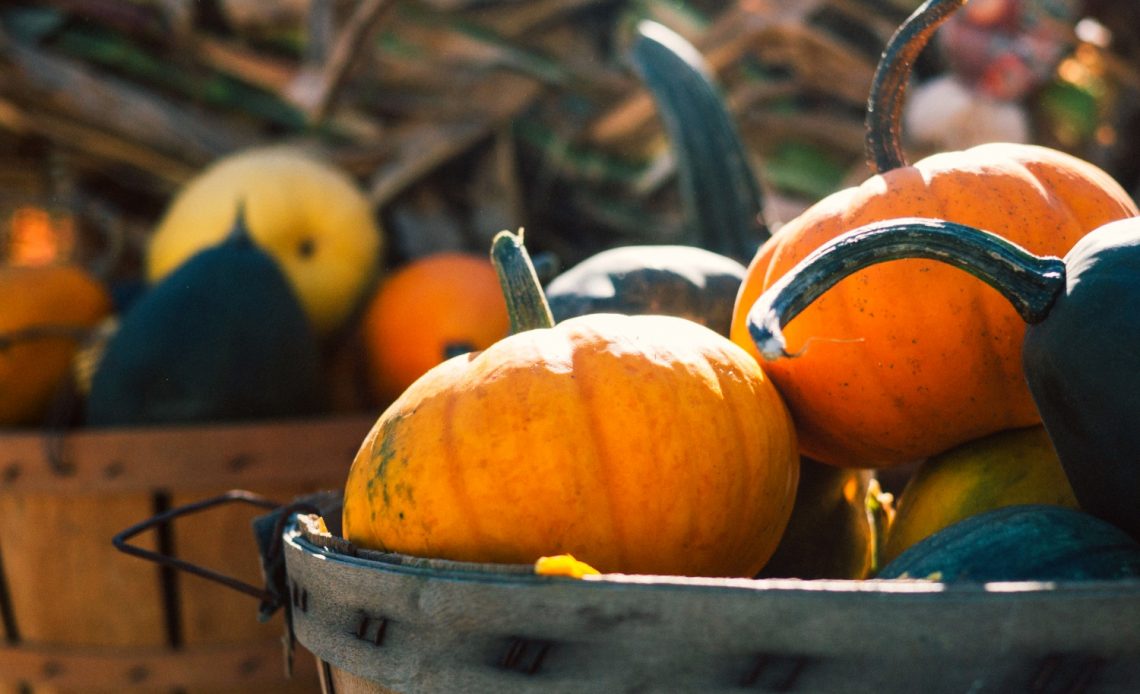

We’re here to help! Wild Yards is a completely free website that is 100% dedicated to helping you create a wildlife-friendly, sustainable yard. Read more
WildYards is reader-supported. When you buy a product through a link on our site, we may earn a comission. Every product is independently selected by our (obsessive) editors and our reviews are unbiased and objective. Read more about our mission or our privacy policy.
Autumn wouldn’t be the same without pumpkins. Whether you grow pumpkins to carve with your kids and decorate your home, or whether you prefer to turn your pumpkins into soups and pies, these easy-to-grow gourds are a worthy addition to any garden. Of course, pumpkins can grow to be pretty big. But just because these garden favorites can be large, that doesn’t mean you have to have a ton of space to grow them. If you want to plant a pumpkin patch, but you’re working with limited room, here are some tips and tricks for growing pumpkins in small spaces.
When working with a small space, you’ve got to grow up, not out. So use wire and wooden trellises and train your pumpkins to climb. Choosing smaller pumpkin varieties will help you maximize your growing space as well.
Growing pumpkins in small spaces: Choose smaller varieties
The key to growing pumpkins in small spaces is to choose small varieties. That makes sense, right? It’s a lot easier to grow smaller cultivars when you don’t have much room to grow in. So instead of choosing gigantic pumpkins, look for the following dwarf varieties, instead.
- ‘Sweetie Pie’ — If you’re looking for something more traditional, choose this tiny cultivar. The Sweetie Pie pumpkin measures 4 to 5 inches in diameter when fully ripe, and comes in a classic shade of pumpkin orange. Sweetie Pie plants produce 2 to 5 pumpkins per plant on average, and they’re just as good for eating as they are for decorating.
- ‘Baby Boo’ — The adorably named Baby Boo is a ghostly white pumpkin that only measures 2 to 3 inches in diameter. Baby Boos aren’t as palatable as other pumpkins, due to their thin, bland flesh. But they’re a cute addition to seasonal table decorations and floral arrangements. Plants typically produce 5 to 7 pumpkins.
- ‘Midnight’ — So dark green they almost appear black, the ghoulish Midnight mini pumpkin adds a pop of unexpected color to your autumnal home decor. Midnight mini pumpkins measure 2 to 4 inches in diameter, and plants produce 2 to 5 pumpkins on average. These pumpkins have deliciously sweet flesh, so they’re just as at home on your dinner plate as they are in your centerpieces.
- ‘Hooligan’ — Short and stout, the Hooligan mini pumpkin measures 3 to 4 inches in diameter and has a sweet, nutty flavor that works especially well in soups and stews. Hooligan pumpkins are bright orange with white to yellow mottling on their ribs, making them especially decorative. Vines typically produce 6 to 12 pumpkins.
If you have enough room in your small growing space to plant 2 or 3 pumpkin vines, then mix and match dwarf varieties to add color to your fall decor. Growing a few different varieties of pumpkins at once will also help you determine which ones you like best, so you can focus on growing those during the next season.
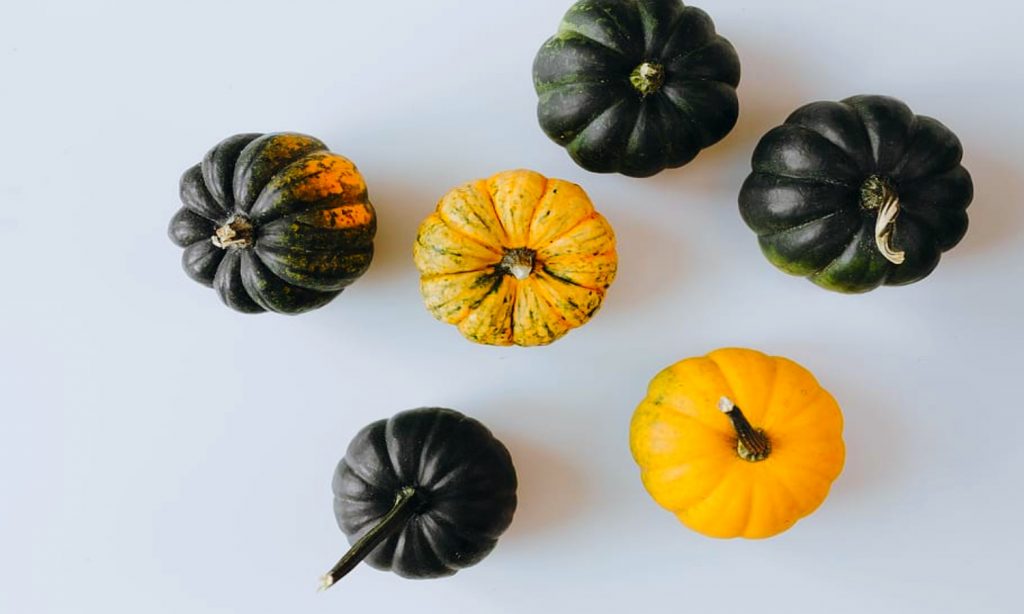
6 Ways to grow pumpkins in a small space
Growing pumpkins in small spaces doesn’t have to be complicated. Much like building a backyard rock garden, you just have to think creatively! Here are 6 ways to grow pumpkins in small spaces to help you get the most out of your tiny garden.
Build a round wire trellis
Pumpkins are vining plants, but they can grow upward just as easily as they can grow outward. If you’re working with limited space, purchase 6-foot welded mesh wire fencing, and cut a 4-foot length of the fencing. Secure the cut ends together to create a cylinder and secure the wire trellis with zip ties. Once it’s ready, set it on top of the soil in your garden and use a shovel to trace around the outside.
Next, you’ll need to dig a circular hole for the trellis to fit into. The hole should be deep enough to help anchor the trellis into place, so roughly 6 to 8 inches deep. When the hole is ready, set the trellis inside and backfill around it. Once the trellis is good to go, transplant 2 to 4 pumpkin seedlings around the outside.
Be sure to space the plants evenly. If you have too many pumpkin plants on one side and not enough on the other, it could cause the trellis to sag and bend when the plants begin to grow. As your pumpkins start producing vines, you’ll need to train them to follow the trellis, so use twine to tie the vines up.
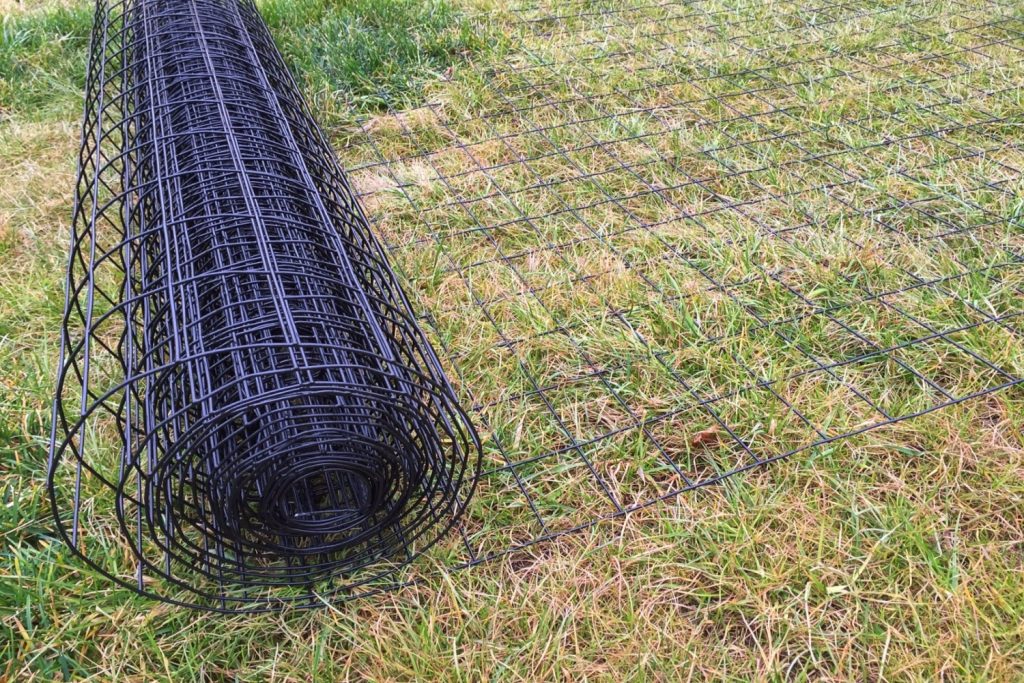
Grow the pumpkins up some lattice
If you live in a subdivision where there is limited space in between houses, install some lattice along the side of your home for pumpkins to climb onto. Pumpkin vines can grow up to 20 feet long but can be pruned back so they don’t take over your entire home. Plus, pumpkins are annuals. So even if they do manage to climb onto your roof, you can easily remove them at the end of the growing season. They aren’t invasive, so you won’t have to fight them year after year.
Lattice makes growing pumpkins in small spaces easy. Simply cut lattice panels to fit the space in question and use staples or small screws to hang them up. You can install the lattice to the side of your house or shed, or onto a privacy fence if you prefer. This is a great way to maximize space, as you can train the pumpkin vines to latch onto the lattice. Use twine to tie the plants up as they grow.
If you plan on growing pumpkins indefinitely, then choose plastic or vinyl lattice, which can last for years. Wooden lattice is a more cost-effective option, but it won’t last as long unless you stain it or paint it to protect it from the weather. Bamboo lattice is an eco-friendly choice, if you can find it, and metal lattice is available for more modern landscapes.
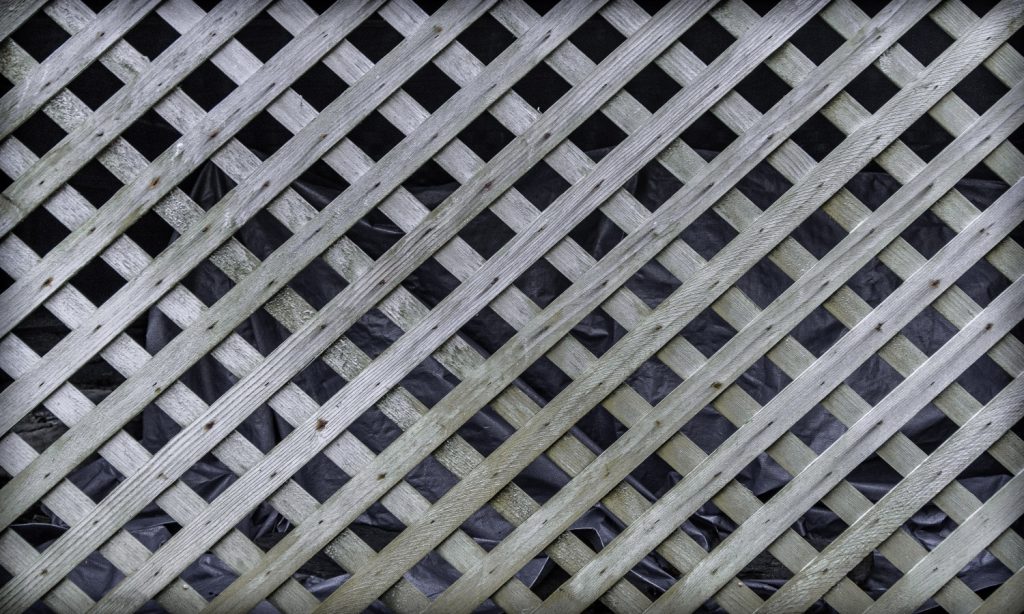
Build an A-frame trellis
If you intend to fill a raised bed with pumpkins and other vining plants, like cucumbers, passion fruit vines, and watermelons, then consider building an A-frame trellis for the space. Use 2 X 4’s to construct a small frame that will fit your raised beds, and lay a wire panel over it to give the vines something to grab onto. If you’ve got an old sawhorse, that will work, too. Just stretch some wire mesh or fencing to cover the outsides, and start growing.
An A-frame trellis will provide your pumpkin plants with better air circulation than they would get if they were growing up the side of a building. Although neither option is a bad one, if you live in a humid environment, then using an A-frame trellis to grow pumpkins in your small space is a better choice.
Grow pumpkins along garden edges
Whether you’re planting in a raised bed or directly in the ground, you can grow pumpkins in a small space by training them to trail around the perimeter of your garden. Pumpkin vines will grow just fine, even if they’re left on the ground. Just pick them up and lay them out wherever you want them to grow.
You’ll need to keep an eye on your pumpkins if you allow them to trail the outer edges of your garden to make sure they don’t try to grow over your other crops. You should also take care to plant your pumpkins near the appropriate companion plants, to prevent competition, repel damaging insects, and attract local pollinators. For best results, grow your pumpkins near corn, marigolds, nasturtiums, radishes, and sunflowers.
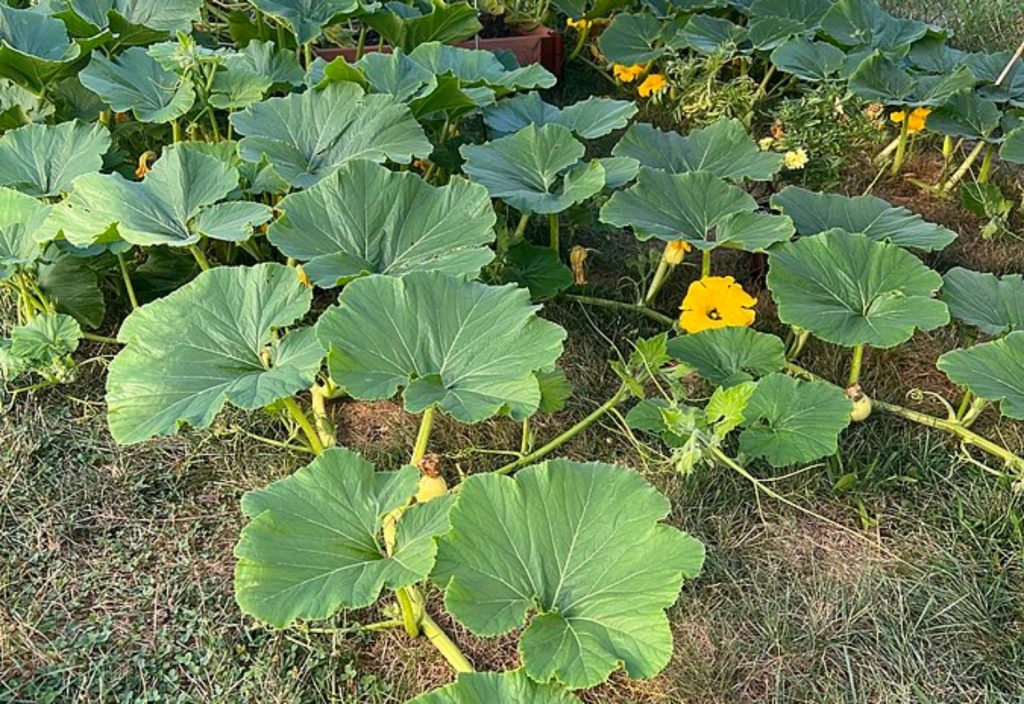
Install a wire fence panel
If low maintenance is the name of the game for you, then this pumpkin-growing hack will be right up your alley. Take two T-posts or tall wooden stakes and drive them into your garden. Then, attach a wire fence panel to them using zip ties or twine. That’s it! Growing pumpkins in a small space have never been easier.
The great thing about this trellis is that it works no matter how much or how little space you have to work with. You can space the posts or stakes as far apart as you need to. You can use any kind of wire paneling you have on hand, whether it’s chicken wire or hog panel. And, should you ever need to move the trellis, disassembly is a breeze.
Grow pumpkins in large storage containers
Maybe you didn’t have enough space in your garden plans to accommodate pumpkins. No worries. Try growing them in large plastic storage containers, instead. Fill the containers with a mixture of 50% topsoil, 30% compost, and 20% organic materials, like peat moss, and be sure to drill some drainage holes into the bottoms.
Once the containers are ready, simply plant your pumpkins and watch them grow. You can also install a round wire trellis in the center of the storage container to give your pumpkins something to grow up. Tomato cages are a good alternative, if you have a few on hand.
When is the right time to grow pumpkins?
Pumpkins are native to North America, where they’ve evolved over thousands of years into the bright orange gourds we know today. Whether you plan on growing pumpkins in small spaces or large ones, you’ve got to start the plants at the right time if you want a healthy harvest. Pumpkins are hardy from zones 3 through 9, and like other cucurbits, they’re incredibly easy to grow.
Start your pumpkin seedlings in peat pots 2 to 4 weeks before the last frost of the spring. For winter gardens, start the seeds in late summer or early fall. Once your seedlings have 2 to 4 sets of true leaves, they’re ready to be transplanted into your garden.
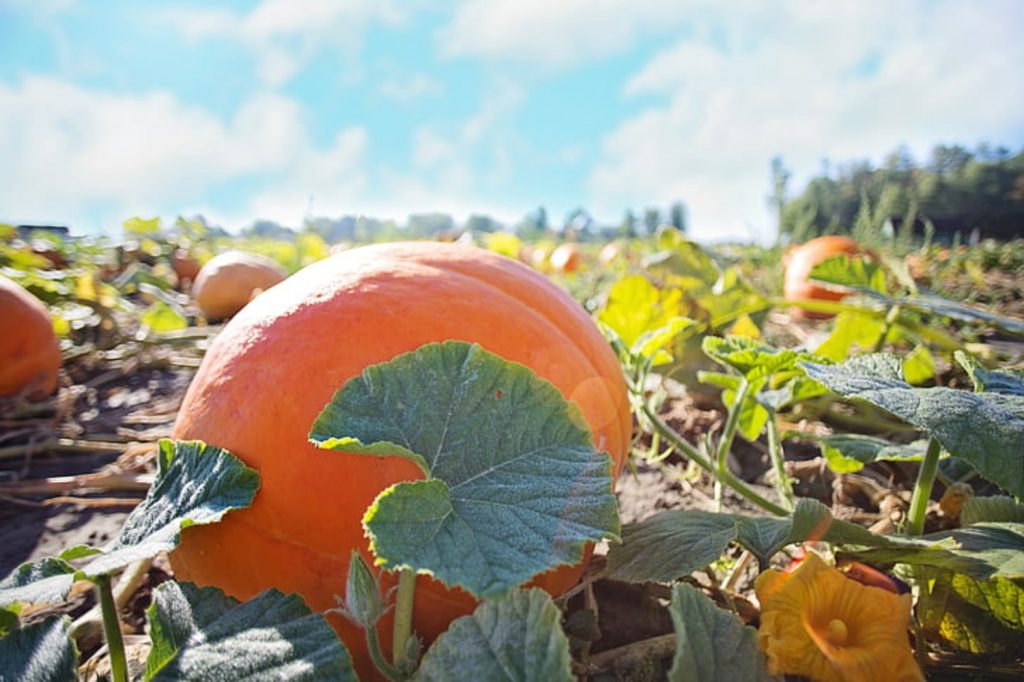
What do pumpkins need to grow well?
Pumpkins are pretty hardy, but they’ll perform best when all of their growing requirements are met. Be sure to plant your pumpkin seedlings in a place where they can receive 6 or more hours of sunlight per day. If you live in a particularly warm climate, provide the plants with some dappled afternoon shade so they don’t wilt during the hottest part of the day.
Pumpkins are heavy feeders. The more nutrients they have at their disposal, the better they’ll grow. So be sure to amend your soil before planting. Use a mixture of compost, worm castings, and manure to make your soil more fertile, and to add structure to it so it retains moisture, yet drains well. All of these decaying organic materials will feed the healthy bacteria in the soil, improving your pumpkin’s disease resistance.
If there’s one thing pumpkin plants hate, it’s sitting in water. Check the soil regularly and water your pumpkins whenever the soil starts to feel dry. If you find that your pumpkin plants are drying out too quickly in between waterings, then spread a layer of wood chip mulch around the base of the plants to prevent rapid evaporation. Pumpkins grow best in moist soils, but muddy soil can lead to root rot.
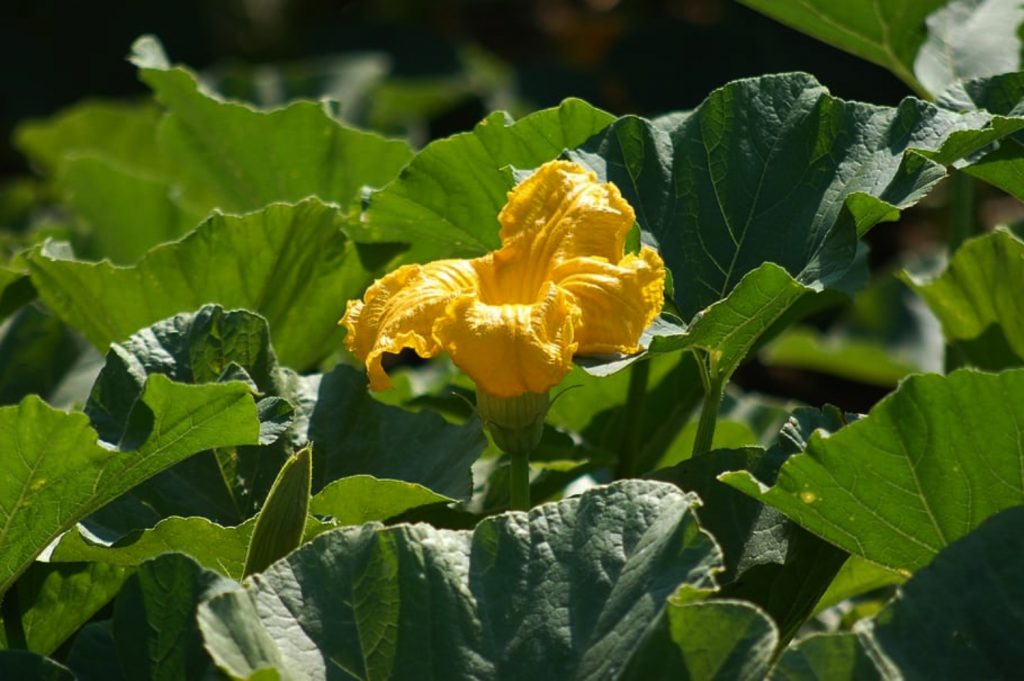
How far apart should you space pumpkins?
One of the struggles of growing pumpkins in small spaces is making sure each plant has enough room. If your pumpkins are too close together, then they may compete for resources, leading to fewer pumpkins come harvest time. So for best results, space your pumpkin plants 1 ½ to 3 feet apart.
Remember, pumpkins are heavy feeders, so be sure to weed your pumpkin patch regularly. Another thing to keep in mind is that pumpkins are not self-pollinating. They rely on outside sources, like insects and the wind, to help them reproduce. Consider growing your pumpkins near plants pollinators love, like sunflowers and lantana. Growing native plants nearby can also help attract beneficial insects.
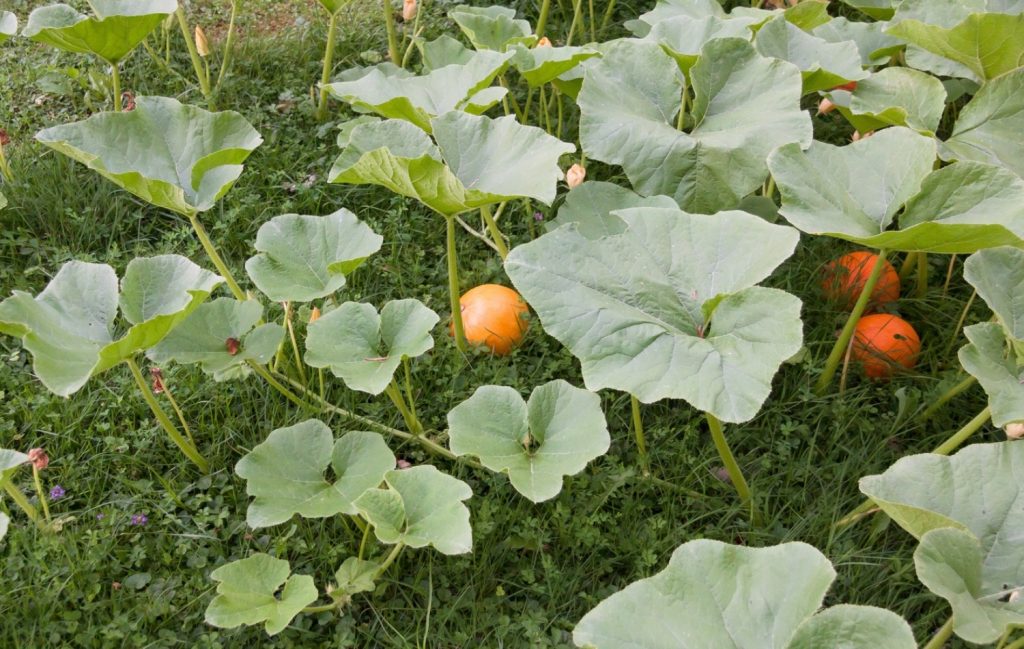
More tips for growing pumpkins in small spaces
As long as you meet their basic needs, growing pumpkins in small spaces won’t hurt the plants a bit. For healthy pumpkins, be sure to turn the gourds gently as they grow to encourage an even shape. Cover the pumpkin’s soil with a board or stone to prevent low-growing gourds from rotting. And use a paintbrush to pollinate the flowers to support a healthy harvest.
Growing pumpkins in small spaces is possible. With the help of these clever ideas, you’ll be enjoying your own homegrown gourds by harvest time.
